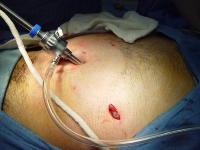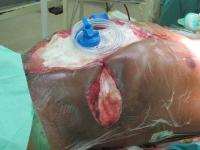BLUNT ABDOMINAL TRAUMA
1. Name of the condition: Blunt abdominal trauma
2. When to suspect/ recognize?
a. Introduction: Blunt abdominal trauma (BAT) is an increasingly common problem encountered in the emergency department. The usual causes of BAT include vehicular accident, assault, falls, sports injuries and natural disasters.
b. Case definition: BAT is suspected in any patient involved in above situations and presents with abdominal pain, distention or shock. It should be looked for in patients of polytrauma.
3. Incidence of the condition in our country: One study has reported 2.1% incidence of BAT amongst all surgical patients admitted to a tertiary hospital during 1 year.
4. Differential diagnosis:Abdominal trauma forms adifferential diagnosis of any patient presenting with acute abdomen.
5. Prevention and counseling: Use of appropriate safety measures during various activities associated with BAT can significantly reduce its incidence.
6. Optimal diagnostic criteria, investigations, treatment and referral criteria:
a. Situation 1 At Secondary Hospital/ Non-metro situation: Optimal standard of treatment in situations where resources are limited
I. Clinical diagnosis:This is based on
a. High level of suspicion of intra-abdominal injury
b. Presence of wounds/ bruising on the abdomen
c. Abdominal guarding/ tenderness
d. Presence of free gas/ fluid in the peritoneal cavity
e. Presence of fracture of lower ribs and/ or pelvis increases the likelihood of intra-abdominal injury
f. Note should be made of altered mental state, drug or alcohol intoxication and distracting injuries which may mask the features of BAT
g. Repeated examination increases the accuracy of diagnosis
II. Investigations:
a. All hemodynamically stable patients with suspected BAT should undergo Focused Abdominal Sonography in Trauma (FAST)or Diagnostic Peritoneal Lavage (DPL)
b. Urgent laparotomy is indicated in patients with evidence of BAT who remain hemodynamically unstable despite initial resuscitation
III. Treatment (Standard operating procedure):
a. Inpatient:
i. All patients should have initial cervical stabilization and resuscitation, if required
ii. Initial fluid resuscitation should be done with 2L warmed Ringer Lactate solution infusedrapidly through 2 peripheral lines
iii. A nasogastric tube and a Foley catheter should be put
iv. Laparotomy should be done, if indicated on the basis of clinical features, FASTor DPL
v. Laparotomy should be done through a long midline incision
vi. Bleeding should be controlled by clamping/ packing till definitive control is possible
vii. Hollow viscus should be repaired
viii. In case the intra-abdominal injuries are extensive, patient is very sick and OT facilities/ surgeon’s experience is suboptimal, Damage Control Surgery may be done. Definitive surgery should be done subsequently under improved circumstances or at a higher center.
b. Outpatient: Not indicated
c. Day care: Not indicated
IV. Referral criteria: After Damage Control Surgery if the local facilities are inadequate.
b. Situation 2 At Superspecialty Facility in Metro location where higher end technology is available
1. Clinical diagnosis: Same as 6a
2. Investigations:
a. Same as 6a
b. CECT abdomen is preferred investigation in all hemodynamically stable patients with BAT
c. Angiography and angioembolization may be considered in hemodynamically stable patients with solid organ injury who are suitable for non-operative management
3. Treatment (Standard operating procedure):
a. Inpatient:
i. Same as 6a
ii. In case the intra-abdominal injuries are extensive, patient is very sick and surgeon’s experience is suboptimal, Damage Control Surgery may be done. Definitive surgery should be done subsequently under improved circumstances
iii. Angiography and angioembolization may be considered in hemodynamically stable patients with solid organ injury who are suitable for non-operative management
b. Outpatient: Not indicated
c. Day care: Not indicated
4. Referral criteria: Not indicated
5
7. Who does what and timelines:
a. Doctor: Does initial evaluation, subsequent monitoring, decision regarding investigations and therapeutic intervention.
b. Nurse: Assists in resuscitation, monitoring, investigation and treatment.
c. Technician: Assists in resuscitation, investigation and treatment.
8. Further reading/ references
a. Udeani J, Steinberg SR. Blunt abdominal trauma. URL: http://emedicine.medscape.com/article/433404-print
b. Joint theatre Trauma System Clinical Practice Guideline: Blunt abdominal trauma.
c. M. Swarnkar, P. Singh & S. Dwivedi : Pattern Of Trauma In Central India: An Epidemiological Study With Special Reference To Mode Of Injury. The Internet Journal of Epidemiology.
By
Dr Sanjay Gupta
Professor, Department of Surgery
University College of Medical Sciences, Delhi



Post a comment